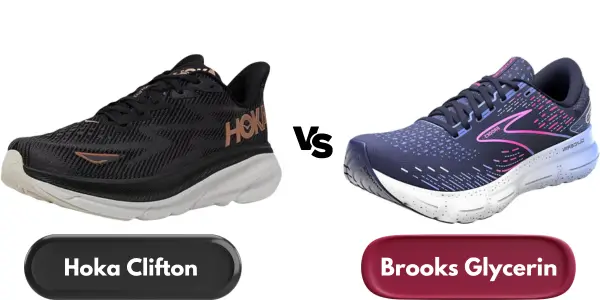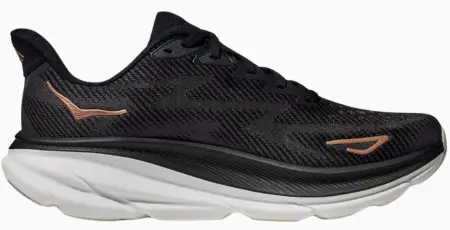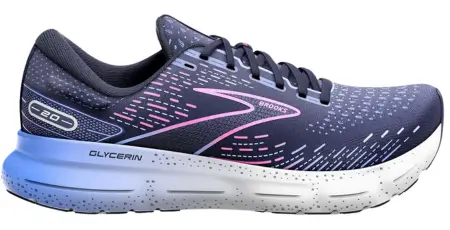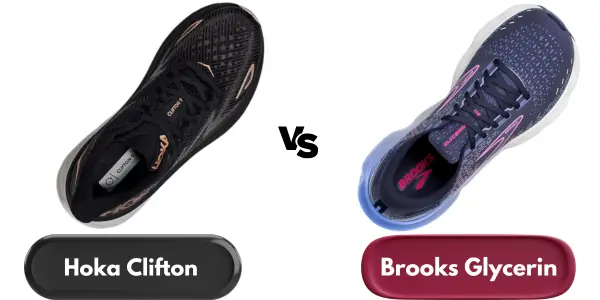Hoka Clifton vs Brooks Glycerin Running Shoe Review
Last Updated: January 01, 2025 | Author: Jake Thompson
In the world of running shoes, two giants stand out: Hoka Clifton and Brooks Glycerin. These shoes are like superheroes of comfort and support, each with their fans cheering them on. Imagine stepping into shoes that make every run feel like you're flying or walking on clouds. That's the magic we're talking about! So, what happens when Hoka Clifton faces off against Brooks Glycerin?
It's not just a shoe battle; it's about finding your perfect running partner. We'll dive into what makes each shoe unique, from their cushiony embraces to how they propel you forward. Are you ready to discover which pair will win a spot in your heart (and on your feet)? Let's lace up and find out together. Keep reading to get the scoop on Hoka Clifton vs Brooks Glycerin and decide which team you're on!

Table of Content:
- Key Takeaways
- Table: Hoka Clifton vs Brooks Glycerin
- Pros & Cons
- Design
- Upper Construction
- Midsole and Outsole
- Cushioning and Support
- Fit and Sizing
- Performance on the Road
- Durability
- Final Verdict
- Frequently Asked Questions
Key Takeaways
- - Hoka Clifton 9 and Brooks Glycerin 20 are designed with advanced cushioning for long-distance comfort and support.
- - Both models feature durable outsoles with superior grip for stability on varied terrains.
- - The Clifton 9 and Glycerin 20 prioritize fit and sizing, offering sizes that cater to swelling during extensive runs.
- - These shoes incorporate materials and construction techniques aimed at enhancing performance while preventing heat and providing foot support.
Table: Hoka Clifton vs Brooks Glycerin

|

|
|
|---|---|---|
| Feature | Hoka Clifton 9 | Brooks Glycerin 20 |
| Terrain | Road | Road |
| Pace | Daily running | Daily running |
| Toebox | Medium | Medium |
| Pronation | Underpronation, Supination, Neutral Pronation | Underpronation, Supination, Neutral Pronation |
| Arch Support | Neutral | Neutral |
| Heel to Toe Drop | 5mm | 10mm |
| Weight | 249g | 286g |
| Cushioning | Balanced | Plush |
| Breathable | ✓ | ✓ |
| Comfortable | ✓ | ✓ |
| Lightweight | ✓ | - |
| Maximalist | ✓ | ✓ |
| Orthotic Friendly | ✓ | ✓ |
| Removable Insole | ✓ | ✓ |
| Rocker | ✓ | - |
| Sockless Wear | ✓ | - |
| Sustainable | - | ✓ |
| Distance | Long distance | Long distance |
| Widths Available | Normal, Wide | Normal, Wide |
| All-day Wear | ✓ | ✓ |
| For Beginners | ✓ | ✓ |
| Jogging | ✓ | ✓ |
| Treadmill | - | ✓ |
| Walking | ✓ | ✓ |
| Strike Pattern | Forefoot/Midfoot strike | Heel strike |
| Collection | Hoka Clifton | Brooks Glycerin |
| Arch Type | High arch | High arch |
| Flexibility | Moderate | Moderate |
| Material | Knit | Mesh |
| Season | Winter | Summer |
| Release Date | Feb 15, 2023 | Jul 2022 |
| No of Colorways | 54 | 49 |
| Forefoot Height | 27mm | 24mm |
| Heel Height | 32mm | 34mm |
| Price |
Pros & Cons
Hoka Clifton 9
Pros:- - Plush cushioning with excellent shock absorption.
- - Lightweight design.
- - Comfortable fit for various foot shapes.
- - Responsive feel for different paces.
- - Less durable outsole.
- - Reduced ground feel due to thick cushioning.
Brooks Glycerin 20
Pros:- - Soft and luxurious DNA LOFT cushioning.
- - Durable outsole for long mileage.
- - Smooth heel-to-toe transition.
- - Adaptive fit for different foot shapes.
- - Heavier compared to similar models.
- - Less flexible sole.
Design
When looking at the Clifton 9 and Glycerin 20, I pay close attention to the outsole, midsole cushioning, and upper construction. These areas make a difference in how the shoe feels when running, whether it keeps your feet stable, comfy, and cool. From my experience, what the shoe is made of and how it's put together matters a lot for runners.
Let's take a closer look at each design aspect for a thorough comparison.
Upper Construction
When comparing both Brooks and Hoka popular running shoes, you'll find some big differences in what they're made of and how they're built. This can change how they feel and perform when you're out for a run. From my experience, here's what stands out:
- - Materials: The Brooks Glycerin 20 uses a softer rubber in its outsole, which provides exceptional cushioning, feeling akin to running on clouds. This feature is especially beneficial during long runs when foot fatigue becomes a factor. On the other hand, the Hoka Clifton 9 utilizes a tougher rubber material, which significantly enhances its durability. From my experience, after numerous runs, the Clifton 9 still retains a near-new appearance, showcasing its longevity.
- - Design: The design of the outsole also plays a crucial role in overall performance. The Hoka Clifton 9 is engineered for stability, which proves invaluable on uneven terrains such as those encountered in trail marathons. Its design helps in maintaining balance through varying conditions. Conversely, the Brooks Glycerin 20 is designed for a smooth transition from heel to toe, aiding in effortless movement during city marathons and making each mile seem less daunting.
- - Grip: Grip is another aspect where both shoes excel, yet with slight differences. The Brooks Glycerin 20 slightly outperforms the Clifton 9 in terms of traction, offering a superior sense of security on diverse surfaces. I recall a particular run on a rainy day where the Glycerin 20 provided exceptional grip, ensuring confidence and stability with every step.
Midsole and Outsole
When looking at the middle and bottom parts of running shoes, it's clear how important the design is for making them last longer and help you not slip.
The Midsole of Hoka Clifton 9 is quick to respond and feels soft when you run, making it comfortable for long distances. Its outsole is made strong in places that usually wear out fast, helping it last longer. The outsole design also helps you not to slip, whether you're running on trails or streets. I found this shoe to be great for my training sessions because it didn't wear out quickly and kept my feet comfortable.
On the other hand, the Brooks Glycerin 20 I tried has a midsole that gives a nice balance between being soft and supportive. The outsole uses tough rubber in just the right spots to avoid quick wear and tear. It also has deep lines cut into it, which makes the shoe bend easily with your foot and grip well on different surfaces. I've worn these on my longer runs and they've been fantastic. They're built to handle lots of miles, and I've noticed they help with keeping my steps smooth and steady.
Both types of shoes have been amazing for my running. They both last a long time and help me stay steady on my feet, but they do it in their special ways.
Cushioning and Support

After running in many marathons and testing out tons of shoes in my store, I've found both Brooks Glycerin 20 and Hoka Clifton 9 to be comfy and stable options for runners. Let me share what I've learned about the padding and support in these shoes.
First off, the Brooks' most cushioned shoe Glycerin 20, known for its plush midsole, feels like you're running on clouds, which is great for keeping your feet comfy. I remember during a particularly long race, the Glycerin 20's cushioning saved my feet from feeling sore afterward.
Then, the Hoka Clifton 9 has this awesome feature where it feels soft, yet it still bounces back with every step I take. It's like the shoe is giving me a little push forward, which helps, especially when I'm starting to feel tired.
I've also worn the Brooks Glycerin 20, which seems to magically fit how I run, making my feet feel supported. This one time, during a downhill run, my feet felt super steady because of this, which was a huge relief.
And, the way the Hoka Clifton 9 is shaped at the bottom helps my feet roll smoothly from heel to toe. This made a big difference in a race where I was struggling to keep a steady pace. It felt like the shoes were helping me move more efficiently.
Overall, I noticed that both the Brooks Glycerin 20 and the Hoka Clifton 9 are good at soaking up the shock every time my foot hits the ground. This means less pain in my knees and ankles, which is a big deal for me. After a particularly rough, rocky trail run, I was expecting to feel beat up, but my joints felt fine, thanks to these shoes.
Fit and Sizing
When picking running shoes, like the Brooks Glycerin 20 and Hoka Clifton 9, it's like solving a fun puzzle. I've run in lots of shoes, and I've learned it's all about how they fit and feel. The Brooks Glycerin 20 offers a fit that's tight enough to keep your foot from moving too much, which is great for people who like a snug fit. I remember this one time during a marathon, my Brooks Glycerin 20s were so snug, they helped me feel secure and fast, even near the finish line.
Then, there are shoes like the Hoka's Clifton 9, with more room at the front, where your toes are. This is perfect for long runs because your feet can swell up a bit. I've had shoes like the Clifton 9 too, and on a long training day, the extra space was a lifesaver. My toes had room to move, and I didn't get any blisters.
Figuring out the right size can be tricky, but the tips from the shoe companies usually help. For both the Brooks Glycerin 20 and the Hoka Clifton 9, I always recommend trying to get the size just right to make sure your runs are comfortable. Too tight or too loose, and it can ruin a good run.
Performance on the Road
When looking for the perfect running shoes, I've tested many to find ones that help during long runs. The Brooks Glycerin 20, with its super thick sole, feels like running on clouds. It's great because it doesn't hurt my feet even after running for miles. I remember using them in a marathon, and they made a huge difference in keeping my feet comfortable the whole time.
Another pair I've tried is the Hoka Clifton 9, which is more traditional but also super comfy. They fit well and let my feet breathe, which is fantastic on hot days. I've worn them for daily jogs, and they always feel just right.
Both the Brooks Glycerin 20 and the Hoka Clifton 9 are great for running. They have special cushioning that supports my feet and helps me run better. I've had great experiences with both, especially during long races where comfort and support are key.
Durability
When I pick running shoes, I always look at how long they'll last. I've tried many shoes, running miles and miles in them. There's this Hoka Clifton 9 with a big cushion that feels soft and protects the shoe, but when you run a lot on roads, they can wear out faster.
Then, there's Brooks Glycerin which has tough rubber and a strong top part. They seem to keep going even after lots of runs, almost up to 500 miles!
From my experience, running in both Clifton 9 and Glycerin 20 holds up perfectly over time. They've been great for long runs and haven't shown much wear. They both are durable from start to finish, without giving me any trouble in marathons. Choosing the right shoe matters, especially if you're running a lot, and from what I've seen, some just last longer and feel better during those long, tough runs.
Final Verdict
In the ultimate showdown between Hoka Clifton vs Brooks Glycerin, it's a close call! Both shoes offer super comfy cushioning, durability, and great support for runners. The Hoka Clifton 9 is light and bouncy, while the Brooks Glycerin 20 is like running on clouds with its plush cushioning. Whether you're tackling long distances or short sprints, these shoes have you covered. So, tie up those laces, hit the road, and let your feet decide which one's the winner for you!
Frequently Asked Questions
1. What's the difference between Brooks Glycerin and Hoka Clifton shoes?
Brooks Glycerin and Hoka Clifton are both highly cushioned daily trainers from two of the most popular brands in running. Glycerin offers a plush feel with a roomier toe box, making it suitable for longer runs and those preferring more space. Clifton, on the other hand, is lighter and features a lower drop, appealing to runners looking for a more natural foot position and efficiency.
2. Do Hoka Clifton shoes run true to size?
Yes, Hoka Clifton shoes typically run true to size. However, they have a slightly smaller toe box compared to some other brands. If you have wide feet or prefer extra room in the toe box, you might consider going up half a size for a more comfortable fit. It's always a good idea to try them on or check the size guide before purchasing.
3. Are Brooks Glycerin shoes good for runners who prefer a softer shoe?
Absolutely! Brooks Glycerin shoes are known for their highly cushioned base, offering a soft and plush ride. They are ideal for runners who prefer a softer shoe and need extra support and comfort, especially on longer runs. Their breathable mesh upper ensures your feet stay cool and comfortable throughout your run.
4. Which shoe is better for someone looking for a lightweight option, Hoka Clifton or Brooks Glycerin?
If you're looking for a lightweight option, you'll likely prefer the Hoka Clifton. Cliftons are designed to be lighter than many competitors, including the Brooks Glycerin, without compromising on cushioning. This makes them a favorite for runners who value speed and efficiency but still want a comfortable, cushioned ride.
5. How should I decide between Brooks Glycerin vs Hoka Clifton?
Deciding between Hoka Clifton and Brooks Glycerin will depend on your personal preferences and running needs. Consider the Hoka Clifton if you want a lighter, more responsive shoe with a lower drop. Opt for the Brooks Glycerin if you prefer a softer, more cushioned ride with more room in the toe box. Both are excellent choices, so you might want to try both and see which feels better for your feet.
Share this:







